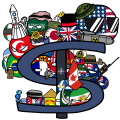Western Bloc: Difference between revisions
No edit summary |
No edit summary |
||
| Line 9: | Line 9: | ||
|onlysuccessor = North Atlantic Treaty Organization | |onlysuccessor = North Atlantic Treaty Organization | ||
|image = Western Bloc.png | |image = Western Bloc.png | ||
|Caption = | |Caption = No [[Eastern Bloc|commies]] allowed! | ||
|Alias = [[File:Capitalism-icon.png]] [[Capitalism|Capitalist Bloc]] | |Alias = [[File:Capitalism-icon.png]] [[Capitalism|Capitalist Bloc]]<br>Western Club | ||
|Time of Exist = 1947/48 - 26 December 1991 (- Present, de facto) | |Time of Exist = 1947/48 - 26 December 1991 (- Present, de facto) | ||
|Government = [[File:Dead Centrism-icon.png]] [[Capitalism|Ideological Alliance]] | |Government = [[File:Dead Centrism-icon.png]] [[Capitalism|Ideological Alliance]] | ||
Latest revision as of 16:05, 21 November 2024
The Western Bloc, also known as the Capitalist Bloc, is an informal, collective term for countries that were officially allied with the ![]() United States during the Cold War of 1947–1991. While the
United States during the Cold War of 1947–1991. While the ![]() NATO member states, in
NATO member states, in ![]() Western Europe and Northern America, were pivotal to the bloc, it included many other countries, in the broader Asia-Pacific region, the Middle East, Latin America, and Africa with histories of anti-Soviet,
Western Europe and Northern America, were pivotal to the bloc, it included many other countries, in the broader Asia-Pacific region, the Middle East, Latin America, and Africa with histories of anti-Soviet, ![]() anti-communist and, in some cases
anti-communist and, in some cases ![]() anti-socialist, ideologies and policies.
anti-socialist, ideologies and policies.
History
The Western Bloc started with the Cold War in 1947, and began to repel ![]() Soviet influence. After USSR collapsed in 1991, the Western Bloc transformed into the modern West of the post-Cold War era.
Soviet influence. After USSR collapsed in 1991, the Western Bloc transformed into the modern West of the post-Cold War era.
Members
 NATO
NATO 
See also: North Atlantic Treaty Organization

 Five Eyes
Five Eyes 



 ANZUS
ANZUS 

 SEATO
SEATO
 Compact of Free Association
Compact of Free Association 

 METO/Baghdad Pact/CENTO
METO/Baghdad Pact/CENTO
 Rio Treaty
Rio Treaty 
 Middle East/North Africa Region
Middle East/North Africa Region 
 Asia, Southeast Asian, and Oceania Partners
Asia, Southeast Asian, and Oceania Partners 
 Others
Others
Gallery
-
Original, more focus on the main members

